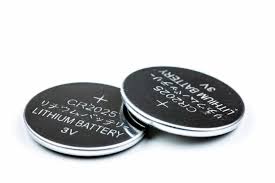Intro
Quick Navigation
If you are familiar with electronic devices, you would know they run on a power source. Most of them are connected to electric circuits (rechargeable batteries), while a couple of others use non-rechargeable batteries. There is no big deal if your device uses electricity to power itself; it is one of the best feelings to have a rechargeable electronic. On the contrary, non-rechargeable batteries are quite difficult and sometimes, unreliable.
Even with the reputation of non-rechargeable batteries not being reliable, they are quite popular. Sometimes, you will find them in flashlights, remotes, wall clocks, wristwatches, etc. They only run for a couple of weeks or months until they can no longer function and needs replacement.
Surprisingly, various types of non-rechargeable batteries exist, depending on the size and capacity. AAA batteries are the most popular types; however, Br2032 and Cr2032 are also significant. They are called Button Cell Batteries. This set of batteries is mostly found in mini electronic devices, like wristwatches.
The purpose of this article, however, is to show the difference between the two, button cell batteries, i.e., Br2032 Vs Cr2032. As similar as they look in size and function, certain things set them apart.
Check out the Button Cell Battery Charts and Sizes available.
Questions
What is Br2032 Battery?
Br2032 Battery is a non-rechargeable 3v Lithium primary button cell battery. It comprises two different components as its positive and negative electrodes – Carbon Monofluoride as the cathode, and Organic electrolyte + Lithium as the anode. It has a stable voltage with a low self-discharge rate, making it suitable for various electronic devices, such as motherboards, watches, etc. However, it has varying operating temperatures depending on the model manufacturer; it often ranges between -25 and +85.
What is the Cr2032 Battery?
Cr2032 Battery is the most popular button cell battery. It is also a non-rechargeable 3v Lithium battery that comes with Manganese dioxide as cathode, and Organic electrolyte + Lithium as the anode. This battery has a standard label, i.e., “2032,” but customized by different manufacturers, e.g., DL2032, DJ2032, KT-CR2032.
Cr2032 uses an open circuit voltage that ranges between 3.2 to 3.3v; thus, it is unstable. It also has a fast self-discharge rate depending on its capacity. It is often told that the shelf-life of this battery is between 7 to 10 years, depending on the model and the manufacturer. It is found in car keys, medical equipment, remote controls, etc.
What are the Differences Between Br2032 and Cr2032?
Both Br2032 and Cr2032 are similar in dimension and operation; however, a few things that set the difference include;
Positive Electrode
One of the factors that make Br2032 and Cr2032 different is the positive electrode. The former uses Carbon monofluoride, while the latter uses Manganese dioxide. These components seem insignificant but they play a huge role in the discharge rate and operating performance.
Voltage
Both button cell batteries are 3v-defined; however, their nominal and cutoff voltages are different. For Br2032, the nominal and cutoff voltage is 2.8v and 2.25v, respectively. For Cr2032, the nominal and cutoff voltage is 3v and 2.0v, respectively.
Capacity
Cr2032 has a large capacity than Br2032. It ranges from 210-230mAh and dependent on the discharge rate. Br2032, on the other hand, ranges from 180-190mAh.
Shelf Life
Based on the shelf life of button cell batteries, it is quite predictable following the discharge rate. Most batteries with low self-discharge rates last longer than those with higher rates. In this case, Br2032 has a longer shelf-life than Cr2032. The former is 10+ years, while the latter ranges between 7 to 10 years.
Operating Temperature
The operating temperature makes them suitable for various electronic devices. Br2032 has an operating temperature between -25℃ and +85, while Cr2032 ranges between -20℃ and +60
Discharge Rate
As mentioned earlier, the discharge rate of Br2032 is extremely low compared to Cr2032.
Weight
Cr2032 and Br2032 both have a similar diameter, i.e., 20mm; however, they have different weights depending on the manufacturer. Br2032 often weighs 2.4g, while Cr2032 weighs 2.8g.
What is the Best Cr2032 Battery Brand?
The batteries are one thing; the brands that make them are another. Many brands are responsible for different models of Cr2032 you see on the market. Now, it could be a bit difficult to know what to choose. Sometimes, people follow reviews from other users to pick what is best.
With that in mind, Duracell, Energizer, Maxwell, and Panasonic are the best manufacturers on the market. You will find each brand unique on its own; often, it is in their amount of units/pack. So, if you are looking for the best Cr2032 battery brand, make sure they offer the amount you are going to need. Moreover, Duracell is a popular manufacturer you can trust.
How to Dispose Of 2032 Batteries?
Every battery has a period when they will be useful; after the expiration, they become useless and need to be disposed of Cr2032 batteries are not an exception. You must properly dispose of the battery to prevent environmental hazards. You would find it surprising that every country or community has regulations on how to dispose of waste, especially batteries. Likewise, you should ensure that the disposed battery doesn’t come in contact with other metals in the trash.
What Devices Use 2032 Batteries?
Special electronic appliances like remote controls, medical equipment like thermometers and tensiometers, watches, car keys, laser pens, etc., make use of 2032 batteries. You could easily say that they are ideal to power smaller devices.
Is LIR2032 Battery Good?
Apart from Cr2032 and Br2032 batteries, there is another special type of button cell battery that works effectively – LIR2032. It is a 3.6v battery with a high self-discharge rate. They are quite useful and often comes with Lithium-Ion 2032 Battery Charger.
Conclusion
Br2032 Vs Cr2032 article isn’t one to dictate why a battery is better than the other; instead, it shows the features that make either of them effective and great. For what is worth, both are useful to power small devices that are significant to everyday use.

